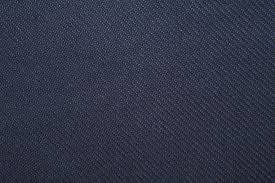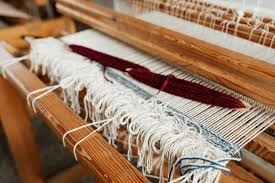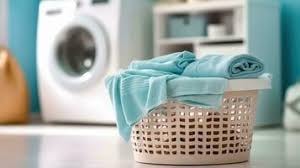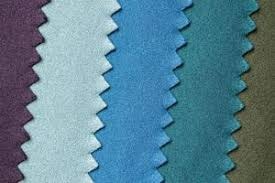
What is Twill Fabric? The woven textile twill exhibits distinctive diagonal lines as its characteristic pattern. Twill weaving produces diagonal lines through a procedure that allows weft threads to move above one or more warp threads, followed by movement below multiple threads. The weaving pattern offsets repeatedly, which produces resilient and chic fabric characteristics.
Twill fabric belongs to a group of three dominant textile weaves inclusive of plain and satin weaves. The unique charm of Twill fabric consists of its great strength and adaptability paired with its special visual pattern structure.
Twill materials enjoy popularity for both decorative and fashion settings because of their relaxed appearance alongside weighty texture relative to alternative weaves.
The fabric twill appears as a main component of garments and home products while it also plays a role in accessory goods. The fabric exhibits strong wear resistance, smooth draping and professional sheen. The diagonal pattern rib defines twill fabric by giving it both refined charm and a hand-feel touch.
Key Characteristics
- The diagonal ribbed pattern that stands out visually and provides texture
- Strong and resilient structure, great for daily wear and tear
- Naturally wrinkle-resistant, it stays looking crisp throughout the day
- Drapes are better than plain weave fabric, offering movement and elegance
- Less transparent than other weaves, ensuring better coverage and modesty
- Good for layering, thanks to its thickness and body
Twill fabric works well across entire ranges of applications, starting with uniforms up through high-fashion designs and extending to utility-based items, including upholstery.
Types of Twill Fabric
Twill isn’t a one-size-fits-all material. Different fibers when woven into the twill structure result in various fabric types. The unique characteristics of each twill fabric type depend on their blend of fibers and their weave tightness together with the finishing treatment.
Gabardine Fabric

Twill fabric appears smooth because of its tightly woven pattern, which forms gabardine. It’s water-resistant and incredibly strong. Gabardine was invented by Thomas Burberry during the late 1800s through the creation of wool materials. The manufacturing industry uses cotton together with wool blends as well as synthetic forms to produce this material.
The fabric has a flat appearance because of its compact design along with its noticeable diagonal folds that disappear into the tight fabric structure. Gabardine fabric keeps its form while aging and presents itself as a neat professional look.
It’s often used for:
- Business suits that need structure and durability
- Trench coats, offering wind and water resistance
- Military uniforms are due to their toughness and clean look
- Outerwear that demands weather resistance without sacrificing aesthetics
Gabardine presents attractive functionality that draws users to carry it in their daily lives for both fashion and functional needs. When worn, it allows air circulation, thus being more comfortable as a substitute for coated synthetic materials.
Cotton Twill

Cotton twill material provides both comfortability and lengthy use to its users. The material feels soft against the skin yet breathes properly enough to be utilized in fabric making. The fabric appearance of cotton twill stands in contrast to gabardine since it presents a relaxed matte finish. This material provides comfort alongside flexibility which makes it suitable for all your ordinary clothing needs.
Common uses include:
- Chinos that balance polish and comfort
- Denim jeans that stand up to rugged wear
- Casual jackets and utility shirts
- Children’s clothes are due to their softness and resilience
- Upholstery and curtains where you want durability and softness
The good dye absorption of cotton twill results in a wide selection of available colors. Cotton twill serves as a multi-functional design component that works well for fashion and interior design applications due to its plain texture combined with soft luster.
Other Twill Variations
- Wool Twill: Wool Twill provides warmth together with structure which finds use primarily in winter coats as well as tailored pants and suits. Cotton twill finds its place in expensive high-end fashion products.
- Polyester Twill: Stain-resistant, wrinkle-resistant, and low-maintenance. Twill fabric finds its main application across uniforms, and hospitality apparel and serves as household items, especially curtains.
- Blended Twill: Blended Twill uses mixed materials of natural fabrics with synthetic ones to merge comfort elements with durability, together with convenient maintenance properties. Workwear, together with industrial items, makes this fabric its optimal application.
- Stretch Twill: Twill with stretch features contains elastane or spandex fibers, which provide elastic properties. Twill appears frequently in tight-fitting clothes, including pencil skirts.
Different types of twill fabrics serve unique practical requirements, which range from weather resistance and comfort to appearance.
How Twill Fabric Is Made

The process of making twill requires exact thread interlacing in a specific order. Cross-weaving forms the diagonal pattern when each row starts its position offset from the one before it.
Weaving Process
Basic fabric weaves into a specific pattern as shown below:
- 2/1 Twill: Weft goes over two warp threads, under one
- 3/1 Twill: Over three, under one, creating a sharper line
- 4/1 Twill: Over four, under one, for a bold and steep pattern
Each time the ratio elevates, the visual strength and slope of the diagonal pattern strengthen, enhancing the fabric’s density and strength.
The distinctive feature of the fabric weave appears when straight crisscross lines do not form. The fabric develops a smooth diagonal pattern that you can observe immediately. The herringbone and chevron styles set the fabric weaves in opposite directions to generate their appealing design.
Tools Used
Rapier and air-jet looms produce precise and detailed twill patterns for current manufacturing needs. Jacquard or dobby looms produce diamond twill and herringbone twill designs. These machines help produce perfect twill results on extensive fabric pieces.
Yanmao Textile uses strong quality checks throughout the production of twill fabric to deliver perfect results in every yard. We evaluate yarn materials while watching thread tension to confirm pattern and texture are the same throughout the product.
Gabardine Fabric: A Twill with a Twist

The term gabardine refers to a unique form of twill fabric production. Twill fabric stands alone because of its dense fabric composition. While having the same diagonal design as twill fabric it features a dense weave that cannot be seen. The tight fabric construction provides the gabardine its polished and supple texture.
In the 19th century, Thomas Burberry developed gabardine to serve as both a breathable and weather-resistant material. The fabric gained fast popularity as an ideal outerwear fiber, particularly for British military uniforms.
Key features:
- Smooth surface with barely visible ribs
- Tight weave for excellent durability
- Water resistance without synthetic coatings
- Crisp and structured feel
- Breathable for year-round comfort
Gabardine delivers an elegant appearance when dealing with challenging weather tasks. It repels stains well, which works well for commercial applications.
Gabardine is widely used in:
- Tailored suits and trousers for a professional edge
- Trench coats that need to block wind and rain
- Uniforms that demand long-term durability
- Business dresses and skirts
- Outerwear with a high-end finish
The fabric’s delicate texture works well in all types of high-end dress clothes and workspace clothing. The material provides an expert-quality appearance while maintaining its functional elements.
Cotton Twill Fabric: Comfort Meets Durability
Cotton twill gives wearers a comfortable feel yet maintains the fabric’s practical uses that gabardine provides. The fabric stands between relaxed and functional qualities.
Wearing it creates a smooth experience while providing excellent air circulation. The fabric weave improves durability without altering its softness or lightweight. Cotton twill possesses a shallow brushed texture that people like to touch. The fabric grows more attractive with age, particularly in pants and coats.

People enjoy working with this fabric due to its simple cutting and sewing abilities. This material can be easily found in stores and costs less than other options.
People prefer using cotton twill fabric for daily wear. It’s found in:
- Chinos and trousers for casual or business-casual settings
- People wear denim jeans for both a strong appearance and relaxed ease.
- Lightweight jackets and utility shirts for seasonal transitions
- People can create their sewing projects with this material because of its flexible design
- Tablecloth and window draperies benefit from this fabric because they feel soft without becoming damaged
Most people choose this fabric for its pleasant touch combined with its toughness in clothing and home goods production.
Pros and Cons of Twill Fabric
Pros
- Durability: When woven diagonally, twill fabric creates a strong fabric that stays intact better than single-thread structures.
- Versatility: Anyone can choose twill fabric for clothing or industrial purposes.
- Wrinkle Resistance: The fabric does not show visible wrinkles because its structure thwarts creasing.
- Stylish Texture: The fabric’s diagonal pattern creates a beautiful style texture.
- Drape: Twill fabric moves gracefully; it cannot duplicate the smoothness of canvas and its tight plain weave.
- Breathability: Natural fiber twills (like cotton) offer good airflow

Cons
- Weight: Heavier twill fabrics make clothing packages unfit for some purposes.
- Finish: Repetition of rough washing tends to make twill fabric less smooth.
- Shrinkage: Washing cotton twill fabric improperly before or after the wash cycle causes it to shrink.
- Pilling: Lower-quality blend fabrics develop small fabric balls called pills during their lifetime.
Even with minor problems, twill is a fabric that works well for various applications.
How to Care for Twill Fabric

By using the correct care methods twill fabric stays well maintained and feels soft. The best care practices depend entirely on what type of fiber your twill fabric contains.
Washing
- Cotton Twill: Machine wash cold or warm on a gentle cycle
- Gabardine: Dry clean or hand wash, especially wool versions
- Synthetic Twills: Machine washable and quick-drying
Always check the care label. Although twill fabric can withstand intense washing cycles, its fibers start weakening when washed at high temperatures.
Ironing
- Use iron while the clothes are damp
- Cotton needs medium heat, while you should use low heat with synthetic fabrics.
- Blow hot steam to eliminate deep wrinkles from the garment and lift the fabric.
Storage
- Draping fabric over natural folds keeps them from forming visible damage.
- Keep in a cool, dry space
- Keep twill garments out of sunlight because it will weaken the fabric colors naturally over time.
Protecting twill garments in either garment bags or muslin cloth reduces damage during storage.
When to Choose Twill Fabric Over Other Materials
Twill proves best against other fabrics depending on the purpose.
Compared to Other Fabrics
- Versus Denim: Twill creates a softer feel and a more formal appearance than denim
- Versus Satin: The strength of twill fabric and its effortless care make it better than satin material
- Versus Canvas: Twill clothes are lighter and move more fluidly than canvas products
- Versus Poplin: When compared to poplin, twill offers an increased textured appearance and better wrinkle resistance
Twill fabric suits products that need both reliable strength and attractive performance.
Choosing Gabardine vs. Cotton Twill
- Use gabardine fabric for formal ensembles that resist water and maintain their shape.
- You will enjoy the natural comfort and breathability of cotton twill for daily use
Each has its place. Gabardine looks great in professional suits and uniform outfits. Cotton will suit everyday casual clothes while allowing people to create their projects.
Final Thoughts: Why Twill Fabric Remains a Timeless Choice

Twill fabric combines a strong construction with an attractive look. Straightforward clothing pieces such as chinos and uniforms depend on this fabric for its lasting popular fashion value. The material works equally well with workwear and luxury coat fabrics.
Twill fabric stands out for these reasons:
- Long-lasting and stylish
- Versatile across seasons and industries
- Easy to care for
- Breathable and comfortable
- Always in fashion, never out of place
Whether you’re designing your next collection or sewing at home, twill fabric offers endless possibilities. Explore more at Yanmao Textile and discover how the right fabric can transform your work.





